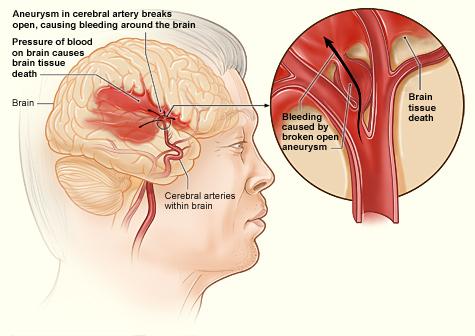The blood supply to a part of your brain is suddenly interrupted.
Ischemic Stroke, approximately 75% of all strokes, can occur when blood supply to your brain is blocked.
Hemmorrhagic Stroke, can occur when there is bleeding in your brain. (Pictured)
Transient Ischemic Attack (TIA) or mini-stroke is a condition similar to stroke, but the symptoms only last seconds or a few minutes and completely resolve within 24 hours. Can be a warning sign of a future stroke, and medical attention should be sought as soon as possible.
Call 911
Stroke is a medical emergency. If you experience any of the symptoms below, seek immediate medical attention.
Can Be Disabling, May Cause Death
Stroke is the fourth most common cause of death in the United States, and the most common cause of permanent disability.
Underlying Causes Treatable if Diagnosed Early
Most causes of stroke are treatable with medical and surgical intervention, provided they are diagnosed early.

Ischemic stroke, where the blood supply to a part of your brain is interrupted, is most commonly related to:
- High blood pressure (hypertension), which can damage the small blood vessels in your brain.
- Abnormal heart rhythms, such as atrial fibrillation, which can cause small blood clots in your heart. These can break off and travel to your brain, blocking the blood supply.
- Hardening of the arteries (atherosclerosis), a buildup of plaque in the carotid arteries that bring blood to your brain. Plaque can build up over time in arteries as you get older due to long-term effects of illnesses like high blood pressure, high cholesterol levels and diabetes. Pieces of this plaque can break off and travel to your brain.
Transient ischemic attack (TIA) has the same causes as ischemic stroke.
Hemmorrhagic stroke, or bleeding within your brain, is typically caused by:
- Head or brain injury.
- Certain types of congenital brain aneurysms.
- Very high blood pressure and bleeding from arteries already diseased from high blood pressure or atherosclerosis.
Once the symptoms of a stroke have already occurred, diagnosis is usually confirmed by obtaining a detailed picture of your brain with either an MRI or computerized tomography (CT) scan.
To prevent a stroke from every occurring, there are other tests that may be performed to evaluate your risk:
- Routine medical evaluation with blood pressure measurements.
- Routine blood tests that measure cholesterol and triglyceride levels.
- An EKG (electrocardiogram) that diagnoses the abnormal heart rhythms which can cause a stroke.
- An echocardiogram (ECHO), an ultrasound picture of your heart, which can diagnose certain heart or heart valve conditions which can cause a stroke.
- A carotid duplex scan, or ultrasound of your carotid arteries, which can reveal plaque buildup or narrowing of the carotid arteries, which can lead to a stroke.
Medication and Rehabilitation
In most cases, treatment following a stroke includes medication and rehabilitation to help you recover skills or faculties affected by the stroke. Unfortunately, many stroke patients do not recover fully.
Vessel Repair
If you are fortunate and reach a high-level medical center within 4-6 hours of the initiation of the stroke, it may be possible to open the damaged or blocked blood vessel with medications or procedures.
Following TIA
If you have a transient ischemic attack, tests can be done to check for possible causes of a future stroke. Preventive treatment may include:
Medication to control high blood pressure and high cholesterol, or thin the blood.
Vessel repair through carotid endarterectomy or balloon angioplasty to open the carotid artery, or placement of a carotid stent to widen the artery.
The best ways to decrease your risk of having a stroke are:
- See your doctor regularly to check your blood pressure and make sure you are on appropriate medications if your blood pressure is high.
- Do not smoke tobacco.
- Exercise regularly, and maintain a healthy weight and lifestyle.
- If you are at risk for heart problems or atherosclerosis, ask your doctor if you should have specific diagnostic tests, such as an echocardiogram or carotid artery ultrasound, so that you can be treated appropriately.
